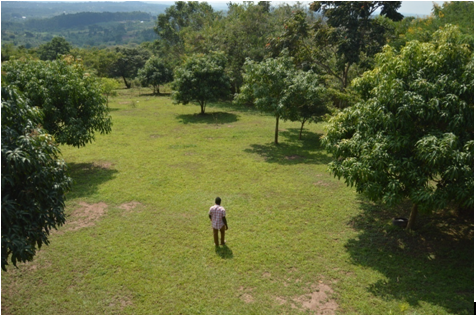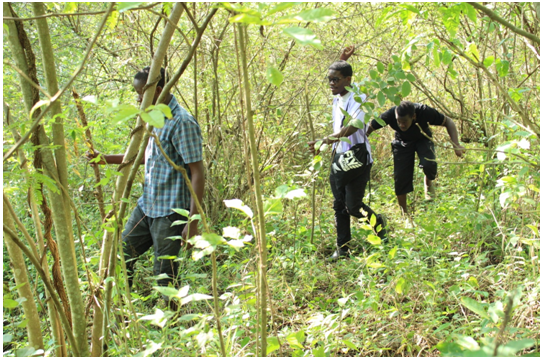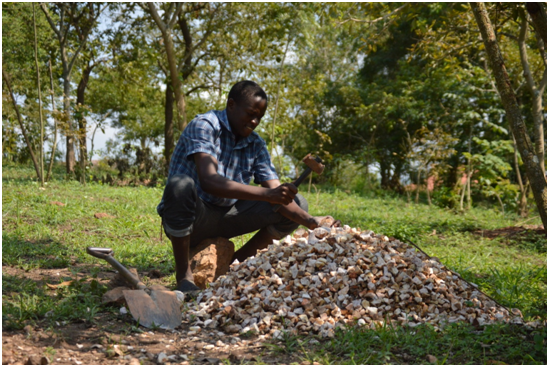- January 30, 2023
- Posted by: mukisahilda
- Category: Uncategorized
The appreciation of sustainable charcoal production as a concept at Camp Besania was sparked off by a road expansion exercise and the timely employment of Richard as an outdoor worker.
The rural-urban migrant presented himself a perfect fit for the job given his years of experience in outdoor work including bush clearing, peasant farming, slashing, stone quarrying and charcoal burning among others. He had cleared all the trees on the family land for charcoal before he joined an illegal group that encroached on a lakeside forest reserve for the same. But the constant scouting of the forest and the arrest of encroachers by the environment police weighed him down so much that he decided to move on.
Richard was then initiated into illegal fishing on Lake Victoria to continue eking an existence. But even here, the scouting arm of the law caught up with him. This time it was the joint force of the environment and the marine police, the latter of which was after illegal fishing tackle. Trees were being felled for charcoal and boat construction. On two occasions Richard narrowly escaped drowning as he tried to beat the marine force at their game. Life was so harsh and unforgiving that it was normal to labor for long hours only to return home with one small fish. The hustling was too much compared to the meager earnings most of which was spent on police bonds and bribes to get off the hook. It was time to move on yet again.
Upon being admitted to Makerere University Richard migrated to Kampala to find any hustles for mobilizing fees that amounted to a hefty US 800 per semester excluding upkeep.

“With the help of my cousin, I threw myself into the open space, alone and deeply skeptical about the move. I dared to start anyway, beginning with the idea of burning charcoal out of the indigenous trees of Camp Besania. In the village, the only value we attached to trees was charcoal; nothing else. The preferred, and by implication, the most endangered species are the indigenous and slow growing hard wood including the velvet bushwillow (endagi) , lemon wood (ettooke-kulu), broad-leaved croton (omukoola), albizia coriaria (omugavu), barkcloth fig (omutuba), African teak (omuvule), acacia hockii ( akasaana), Albizia zygia (ennongo) and jumpin-seed tree (omusasa), among others. They have low moisture content and yield high quality charcoal.
As a typical charcoal producer I perceived the woodland owners of Camp Beania so ignorant of the wealth that was right before them. The village folk that I had left behind had congratulated me upon landing on a green gold mine and urged me to harvest the trees. I quickly showcased my competence with three sacks of charcoal from the bushwillow that had turned deadwood for overhanging the expanded feeder road.”
But my dream of a green gold mine never matured. Very soon I was to learn that I could only cut trees in line with the sustainable charcoal production guidelines of the conservation site. I would only burn enough charcoal to make the campsite self sustaining in wood energy. I must minimize waste by clearing as much charcoal material as possible from the earth kiln. The charcoal dust must be stored away for making briquettes at a later time. Soon I would learn new concepts such as forest management; deforestation and reforestation, sustainable and unsustainable tree harvesting practices forcharcoal production; green gas emissions and carbon credits; promotion of environment conservation practices and mitigation of climate change among others. I would care for the existing trees, plant even more and only harvest with special permission from management.

Soon I was converted into the green economy. Nature conservation offered many sustainable opportunities for income generation that were incomparable to the dead-end practice of charcoal burning. Eco-preneurship was the way to go – intercropping forest trees with fruit trees and climbers; pruning and thinning trees for wood energy; marketing outdoor space for camping activities; promoting eco tourism; harvesting rain water from eco friendly infrastructure; organizing educational programs for the community and encouraging research activities. The list is endless as long as one cares to be innovative and consultative.

The desire to return to my village to make converts of my peers grew by the day. I felt like St Paul, arrested mid career and commissioned back to “Damascus” to convert my peers. They will not believe my U-turn but I will convince them. I will start by re-planting our family land with numerous tree species, starting with the fruit trees that we indiscriminately depleted for quick cash. We cut down the mangoes, the jackfruit, the jambul, the canarium and all the nursing trees in the banana plantations that nature had grown for many years. I have since learnt that it takes 250 kg of wood to yield a 25-50 kg bag of charcoal depending on the moisture content and the hardness of the wood. And the market price is a paltry USD 20-30. No wonder our lives never improved. No matter how many trees we cut we remained poor and cash trapped. Highly regrettable; but we can find solace in the space of beginning again.
Progressively I realized the connection between my academic Programme of Social Work with the cause of environment conservation. Conservation issues require a multidisciplinary approach and Social Scientists play the role of mind-set changers, influencing people from attitudes that cause the destruction of nature. In the foreseeable future Africa may not graduate from the use of wood fuel that is responsible for a large percentage of forest degradation. But the destruction can be minimized through efficient use and sustainable collection of wood fuel. Firewood and/or charcoal burning from abscission, thinning, raising, reduction and dead-wooding plus the use of briquettes, wood pellets and energy saving stoves are some of the worthwhile ideas.

Today environment conservation work (rather than destruction) is the source of a sustainable income for my university education and upkeep. In addition to forest management, my rudimentary skills in stone quarrying are positively utilized to crash surface stone into aggregates that reduce the cost of construction at the campsite. All this plus gardening is done at great leisure and with a high sense of accomplishment that I could never find in the world of environment degradation. So many doors had refused to open for me that I became negative about any apparent opportunities and blessings. But Nature let me in.
At the campsite I embraced Jesus Christ as my personal Lord and savior, one who forgives sin and gives assurance of eternal life. As a Christian I was to learn that in addition to the salvation of human souls, God is equally interested in the comfort of the human race here on earth. Thus from creation He commissions us to tend the Garden of Eden, the environment. And the theme of conservation is variously taken up in the spiritual world, naming Jesus Christ the Master Gardener of human souls. The earth cannot settle outside the least of God’s commissions.
25He made the wild animals according to their kinds, the livestock according to their kinds, and all the creatures that move along the ground according to their kinds. And God saw that it was good.26 Then God said, “Let us make mankind in our image, in our likeness, so that they may rule over the fish in the sea and the birds in the sky, over the livestock and all the wild animals, and over all the creatures that move along the ground.” 27 So God created mankind in his own image, in the image of God he created them; male and female he created them.28 God blessed them and said to them, “Be fruitful and increase in number; fill the earth and subdue it. Rule over the fish in the sea and the birds in the sky and over every living creature that moves on the ground.”